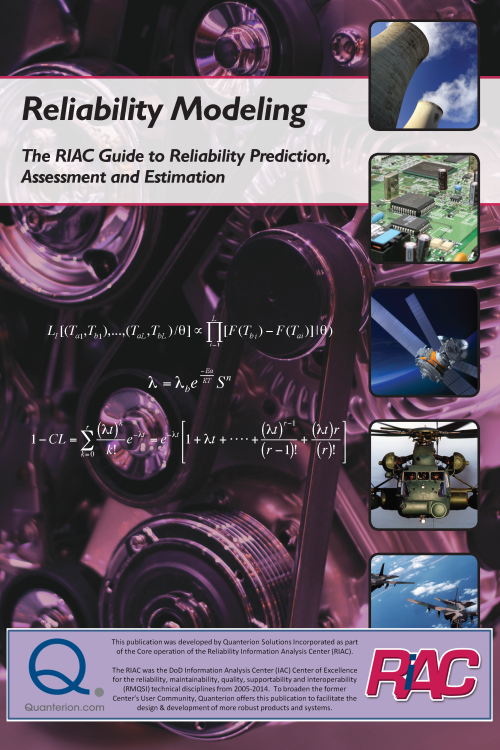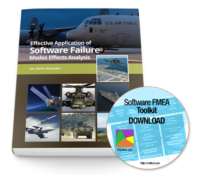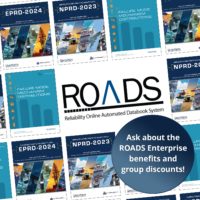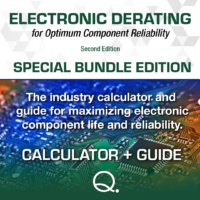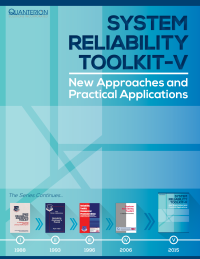| 1. INTRODUCTION |
1 |
| 1.1. Scope |
2 |
| 1.2. Book Organization |
5 |
| 1.3. Reliability Program Elements |
7 |
| 1.4. The History of Reliability Prediction |
11 |
| 1.5. Acronyms |
17 |
| 1.6. References |
18 |
| 2. GENERAL ASSESSMENT APPROACH |
19 |
| 2.1. Define System |
20 |
| 2.2. Identify the Purpose of the Model |
22 |
| 2.3. Determine the Appropriate Level at Which to Perform the Modeling |
25 |
| 2.3.1. Level vs. Data Needed |
26 |
| 2.3.2. Using an FMEA as the basis for a reliability model |
28 |
| 2.3.3. Model Form vs. Level |
34 |
| 2.4. Assess Data Available |
36 |
| 2.5. Determine and Execute Appropriate Approach |
38 |
| 2.5.1. Empirical |
44 |
| 2.5.1.1. Test |
44 |
| 2.5.1.2. Field Data |
77 |
| 2.5.2. Physics |
106 |
| 2.5.2.1. Stress/Strength Modeling |
106 |
| 2.5.2.2. First Principles |
111 |
| 2.6. Combine Data |
114 |
| 2.6.1. Bayesian Inference |
121 |
| 2.7. Develop System Model |
123 |
| 2.7.1. Monte Carlo Analysis |
127 |
| 2.8. References |
133 |
| 3. FUNDAMENTAL CONCEPTS |
135 |
| 3.1. Reliability Theory Concepts |
135 |
| 3.2. Probability concepts |
142 |
| 3.2.1. Covariance |
142 |
| 3.2.2. Correlation Coefficient |
142 |
| 3.2.3. Permutations and Combinations |
143 |
| 3.2.4. Mutual Exclusivity |
144 |
| 3.2.5. Independent Events |
144 |
| 3.2.6. Non‐independent (Dependent) Events |
145 |
| 3.2.7. Non‐independent (Dependent) Events: Bayes Theorem |
146 |
| 3.2.8. System Models |
146 |
| 3.2.9. K‐out‐of‐N Configurations |
151 |
| 3.3. Distributions |
153 |
| 3.3.1. Exponential |
159 |
| 3.3.2. Weibull |
160 |
| 3.3.3. Lognormal |
166 |
| 3.4. References |
169 |
| 4. DOE‐BASED APPROACHES TO RELIABILITY MODELING |
171 |
| 4.1. Determine the Feature to be Assessed |
172 |
| 4.2. Determine Factors |
172 |
| 4.3. Determine the Factor Levels |
172 |
| 4.4. Design the Tests |
174 |
| 4.5. Perform Tests and Measurements |
180 |
| 4.6. Analyze the Data |
181 |
| 4.7. Develop the Life Model |
183 |
| 4.8. References |
183 |
| 5. LIFE DATA MODELING |
185 |
| 5.1. Selecting a Distribution |
185 |
| 5.2. Parameter Estimation Overview |
186 |
| 5.2.1. Closed Form Parameter Approximations |
189 |
| 5.2.2. Least Squares Regression |
190 |
| 5.2.3. Parameter Estimation Using MLE |
192 |
| 5.2.3.1. Brief Historical Remarks |
193 |
| 5.2.3.2. Likelihood Function |
193 |
| 5.2.3.3. Maximum Likelihood Estimator (MLE) |
195 |
| 5.2.4. Confidence Bounds and Uncertainty |
198 |
| 5.2.4.1. Confidence Bounds with MLE |
198 |
| 5.2.4.2. Confidence Bounds Approximations |
199 |
| 5.3. Acceleration Models |
206 |
| 5.3.1. Fundamental Acceleration Models |
207 |
| 5.3.1.1. Examples |
208 |
| 5.3.2. Combined Models |
210 |
| 5.3.3. Cumulative Damage Model |
214 |
| 5.4. MLE Equations |
216 |
| 5.4.1. Likelihood Functions |
217 |
| 5.5. References |
221 |
| 6. INTERPRETATION OF RELIABILITY ESTIMATES |
223 |
| 6.1. Bathtub Curve |
223 |
| 6.2. Common Cause vs. Special Cause |
225 |
| 6.3. Confidence Bounds |
238 |
| 6.3.1. Traditional Techniques for Confidence Bounds |
238 |
| 6.3.2. Uncertainty in Reliability Prediction Estimates |
240 |
| 6.4. Failure Rate vs pdf |
243 |
| 6.5. Practical Aspects of Reliability Assessments |
245 |
| 6.6. Weibayes |
245 |
| 6.7. Weibull Closure Property |
246 |
| 6.8. Estimating Event‐Related Reliability |
247 |
| 6.9. Combining Different Types of Assessments at Different Levels |
248 |
| 6.10. Estimating the Number of Failures |
250 |
| 6.11. Calculation of Equivalent Failure Rates |
251 |
| 6.12. Failure Rate Units |
252 |
| 6.13. Factors to be Considered When Developing Models |
253 |
| 6.13.1. Causes of Electronic System Failure |
253 |
| 6.13.2. Selection of Factors |
255 |
| 6.13.3. Reliability Growth of Components |
257 |
| 6.13.4. Relative vs. Absolute Humidity |
259 |
| 6.14. Addressing Data with No Failures |
259 |
| 6.15. Reliability of Components Used Outside of Their Rating |
261 |
| 6.16. References |
262 |
| 7. EXAMPLES |
263 |
| 7.1. MIL‐HDBK‐217 Model Development Methodology |
264 |
| 7.1.1. Identify Possible Variables |
266 |
| 7.1.2. Develop Theoretical Model |
266 |
| 7.1.3. Collect and QC Data |
267 |
| 7.1.4. Correlation Coefficient Analysis |
268 |
| 7.1.5. Stepwise Multiple Regression Analysis |
270 |
| 7.1.6. Goodness‐of‐Fit Analysis |
271 |
| 7.1.7. Extreme Case Analysis |
272 |
| 7.1.8. Model Validation |
272 |
| 7.2. 217Plus Reliability Prediction Models |
273 |
| 7.2.1. Background |
273 |
| 7.2.2. System Reliability Prediction Model |
274 |
| 7.2.2.1. 217Plus Background |
274 |
| 7.2.2.2. Methodology Overview |
277 |
| 7.2.2.3. System Reliability Model |
278 |
| 7.2.2.4. Initial Failure Rate Estimate |
279 |
| 7.2.2.5. Process Grading Factors |
280 |
| 7.2.2.6. Basis Data for the Model |
281 |
| 7.2.2.7. Uncertainty in Traditional Approach Estimates |
281 |
| 7.2.2.8. System Failure Causes |
282 |
| 7.2.2.9. Environmental Factor |
287 |
| 7.2.2.10. Reliability Growth |
291 |
| 7.2.2.11. Infant Mortality |
292 |
| 7.2.2.12. Combining Predicted Failure Rate with Empirical Data |
292 |
| 7.2.3. Development of Component Reliability Models |
292 |
| 7.2.3.1. Model Form |
292 |
| 7.2.3.2. Acceleration Factors |
294 |
| 7.2.3.3. Time Basis of Models |
294 |
| 7.2.3.4. Failure Mode to Failure Cause Mapping |
295 |
| 7.2.3.5. Derivation of Base Failure Rates |
296 |
| 7.2.3.6. Combining the Predicted Failure Rate with Empirical Data |
296 |
| 7.2.3.7. Estimating Confidence Levels |
298 |
| 7.2.3.8. Using the 217Plus Model in a Top-Down Analysis |
298 |
| 7.2.3.9. Capacitor Model Example |
299 |
| 7.2.3.10. Default Values |
301 |
| 7.2.4. Photonic Model Development Example |
303 |
| 7.2.4.1. Introduction |
303 |
| 7.2.4.2. Model development methodology and results |
306 |
| 7.2.4.3. Uncertainty Analysis |
322 |
| 7.2.4.4. Comments on Part Quality Levels |
325 |
| 7.2.4.5. Explanation of Failure Rate Units |
325 |
| 7.2.5. System‐Level Model |
326 |
| 7.2.5.1. Model Presentation |
326 |
| 7.2.5.2. 217Plus Process Grading Criteria |
328 |
| 7.2.5.3. Design Process Grade Factor Questions |
330 |
| 7.2.5.4. Manufacturing Process Grade Factor Questions |
336 |
| 7.2.5.5. Part Quality Process Grade Factor Questions |
340 |
| 7.2.5.6. System Management Process Grade Factor Questions |
342 |
| 7.2.5.7. Can Not Duplicate (CND) Process Grade Factor Questions |
346 |
| 7.2.5.8. Induced Process Grade Factor Questions |
347 |
| 7.2.5.9. Wearout Process Grade Factor Questions |
348 |
| 7.2.5.10. Growth Process Grade Factor Questions |
349 |
| 7.3. Life Modeling Example |
350 |
| 7.3.1. Introduction |
350 |
| 7.3.2. Approach |
350 |
| 7.3.3. Reliability Test Plan |
350 |
| 7.3.4. Results |
352 |
| 7.3.4.1. Times to Failure Summary |
352 |
| 7.3.4.2. Life Models |
354 |
| 7.4. NPRD Description |
357 |
| 7.4.1. Data Collection |
358 |
| 7.4.2. Data Interpretation |
361 |
| 7.4.3. Document Overview |
366 |
| 7.4.3.1. “Part Summaries” Overview |
366 |
| 7.4.3.2. “Part Details” Overview |
373 |
| 7.4.3.3. Section 4 “Data Sources” Overview |
374 |
| 7.4.3.4. Section 5 “Part Number/MIL Number” Index |
374 |
| 7.4.3.5. Section 6 “National Stock Number Index with Federal Stock Class” |
375 |
7.4.3.6. Section 7 “National Stock Number Index without Federal Stock Class
Prefix” |
375 |
| 7.5. References |
375 |
| 8. THE USE OF FMEA IN RELIABILITY MODELING |
377 |
| 8.1. Introduction |
377 |
| 8.2. Definitions |
381 |
| 8.3. FMEA Logistics |
383 |
| 8.3.1. When initiated |
383 |
| 8.3.2. FMEA Team |
383 |
| 8.3.3. FMEA Facilitation |
384 |
| 8.3.4. Implementation |
385 |
| 8.4. How to Perform an FMEA |
385 |
| 8.5. Identify System Hierarchy |
387 |
| 8.6. Function Analysis |
388 |
| 8.7. IPOUND Analysis |
388 |
| 8.8. Identify the Severity |
390 |
| 8.9. Identify the Possible Effect(s) that Result from Occurrence of Each Failure Mode |
392 |
| 8.10. Identify Potential Causes of Each Failure Mode |
392 |
| 8.11. Identify Factors for Each Failure Cause |
398 |
| 8.11.1. Accelerating Stress(es) or Potential Tests |
398 |
| 8.11.2. Occurrence |
398 |
| 8.11.2.1. Occurrence Rankings |
398 |
| 8.11.3. Preventions |
401 |
| 8.11.4. Detections |
401 |
| 8.11.5. Detectability |
401 |
| 8.12. Calculate the RPN |
404 |
| 8.13. Determine Appropriate Corrective Action |
405 |
| 8.14. Update the RPN |
408 |
| 8.15. Using Quality Function Deployment to Feed the FMEA |
408 |
| 8.16. References |
410 |
| 9. CONCLUDING REMARKS |
411 |


